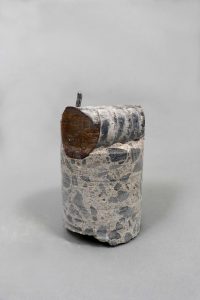With August coming to an end, we would like to highlight one more artifact from within our collection for Archaeology Month. This blog post will discuss the concrete cores of the Diefenbunker and will examine their archaeological and architectural impact.
Archaeology examines the material remains of the past, which encompasses objects, artifacts, specimens, and other physical evidence. However, archaeology can also be linked to architecture, as both are interdisciplinary fields of study. Archaeology investigates and provides an understanding of the world as we know it and assists in the preservation of artifacts and architectural landmarks with historical significance. Specifically, the link between archaeology and architecture examines the construction techniques of buildings by analyzing their structures and foundations.

Concrete Core, Diefenbunker Museum Collections.
Concrete cores are retrieved through the process of drilling cylindrical holes into the foundation of a building using a rotary cutting tool with diamond bits. This tool is non-invasive and leaves a perfectly drilled hole where the core can then be removed. This action is performed during the construction process for a multitude of reasons. Primarily, concrete coring is done in order to test the properties of the concrete, it helps increase the stability of a structure, and it determines the strength and density of both the structure and the material.
In the Diefenbunker’s collection, there are several core samples that help visualize the structural composition and integrity of the bunker. The bunker is 100,000 square feet, constructed with 24,500 cubic meters of hand-poured concrete and 4,535 tonnes of reinforcing steel. Core Sample – Bank of Canada Vault is an artifact within our collection and is a prime example of where concrete and steel work together. This artifact visually encapsulates the structural composition of the concrete and demonstrates how the vault was strengthened.

Concrete Core, Diefenbunker Museum Collections.
Core Sample – Bank of Canada Vault is a large cylindrical cement core that is light grey with rectangular specs of dark grey throughout. This core has an X-shaped piece of steel affixed to the bottom left side of the core, and an upside down Y-shaped piece affixed to the bottom right side. These fragments of steel are called rebar. Rebar, also commonly referred to as reinforcing bar, is a non-corroding bar made of steel that is used in concrete construction. Rebar adds tension to the concrete which aids in the overall reinforcement of the building. At two inches in diameter, the rebar used for the bunker is four times the size of standard rebar. Given the bunker’s intended purpose of being able to withstand a five megaton nuclear blast, it was essential that these fortifications were in place to guarantee stability.
More information on the concrete cores of the Diefenbunker can be found on the 400 Level in the Building the Bunker exhibition, where the cores are currently on display.
Stay tuned for more artifact highlights on our blog to uncover Cold War stories from our museum’s collection.
Learn more:
Archaeology Month 2022 Blog Post: http://diefenbunker.ca/archaeology-month-2022/
The Atom Struck Tile Blog Post: http://diefenbunker.ca/the-atom-struck-tile-2022/
